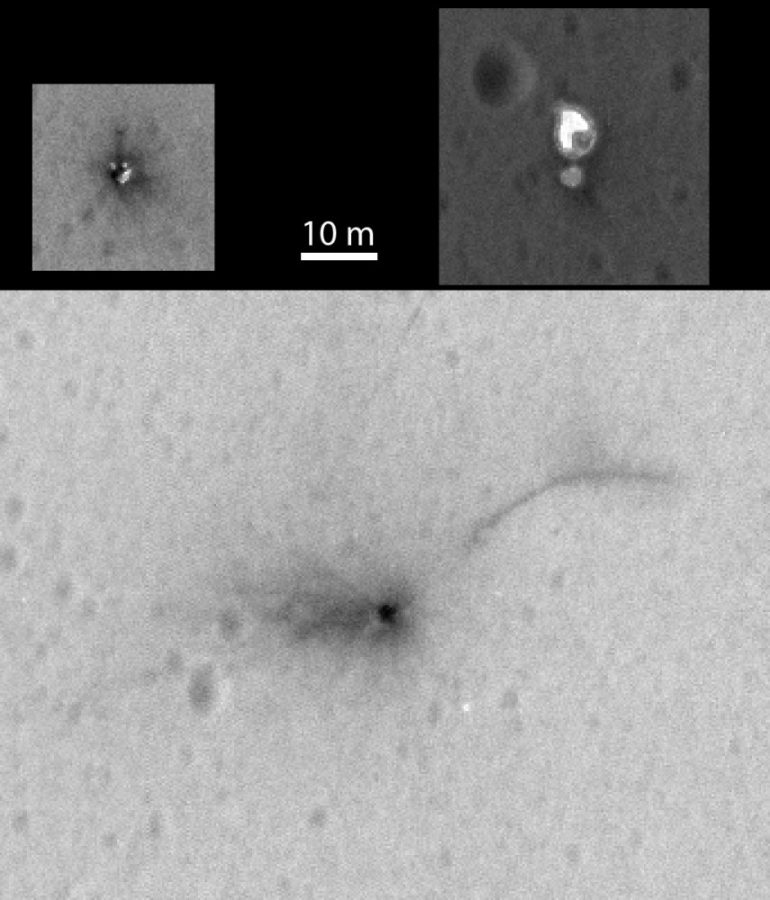An orbital telescope run by UA researchers recently captured the first color images of the wreckage of a failed Mars lander on the surface of the planet.
The High-Resolution Imaging Science Experiment, is one of the UA’s most prolific astronomical endeavors. The camera was built by Ball Aerospace & Technologies Corp. in 2005 and is operated by UA faculty at the UA Lunar and Planetary Laboratory on campus. It’s currently aboard NASA’s Mars Reconnaissance Orbiter, a satellite intended to study the history of water on Mars.
RELATED: UA research finds evidence supporting the existence of a ninth planet beyond Neptune
HiRISE analysts recently released the first color images of a crashed lander on the surface of Mars. The ExoMars Schiaparelli lander was part of a mission by the European Space Agency and Russian space agency, Roscosmos. It primarily served as a test lander to for future missions to Mars. A malfunction in its Oct. 19, descent caused it to crash land.
“The images of the impact site can be used to help the ESA engineers to understand when events might have occurred during the Schiaparelli entry, descent and landing sequence,” said Sarah Sutton, planetary sciences graduate student and longtime HiRISE staff member. “By looking at the positions of the heat shield, main impact, parachute and backshell (a protective cover for the parachute), they can perhaps back out their incoming trajectories and velocities, and match that with the lander telemetry during EDL. This lander was a technology demonstration for ESA, so all of the knowledge about its performance will be valuable.”
This was not the first time that HiRISE was on the forefront of Martian imaging.
“HiRISE has imaged successful and unsuccessful landings,” Sutton said. “Two of the most spectacular images ever taken by any orbiting camera, much less HiRISE, were the EDL images of the Phoenix lander. … Other, less successful landings have been imaged by HiRISE, which helped mission planners understand perhaps what went wrong.”
Mars is a big planet and HiRISE is a relatively small telescope that allows for high resolution photographs of small areas, according to Sutton. So far it’s only imaged less than two percent of the martian surface thus far, causing scientists to selectively point the telescope’s lens at only the most interesting features of Mars.
HiRISE also makes the planning of current and future explorations possible by supplying the information with which candidate landing sites are characterized, according to Sutton. The optical power of HiRISE combined with other instruments on the Mars Reconnaissance Orbiter look for landing sites based off surrounding hazards like steep slopes and large rocks. It’s also being used to find possible future sites for human exploration on the red planet.
Not only has HiRISE imaging aided in landing analysis, but has also allowed for new discoveries about the red planet, according to Sutton.
RELATED: UA graduate student discovers planet with three suns using the Very Large Telescope
“Over the length of the mission so far, one of the great results that have come from HiRISE images is that Mars’ surface is active,” Sutton said. “There are active dunes on Mars, avalanches, dust devils, gully formation, carbon dioxide-driven processes, and possible activity of liquid water on the surface today.”
HiRISE team members at UA have unique roles in the MRO mission.
“One of the most important roles of UA scientists that work on MRO is outreach,” Sutton said. “Getting the word out about this incredible mission and how it involves the UA community … people are really excited about Mars, and we want them to know that some of the most exciting discoveries about Mars are being made right here at the UA.”
The HiRISE images are available to the public on uahirise.org.
Follow Chandler Donald on Twitter.









